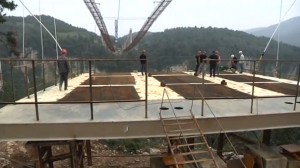China has begun construction on what it claims will be the longest and tallest glass-bottom bridge in the world.
The bridge will be suspended across Zhangjiajie Grand Canyon in Hunan’s scenic Zhangjiajie National Park, which has claims to have inspired visuals for James Cameron’s 2009 film “Avatar”.
An investor founded Zhangjiajie Grand Canyon Co. Ltd to to carry out the project and is putting a total of around 250 million yuan ($39 million) into the bridge’s construction.
Israeli Haim Dotan, who designed the Expo 2010 Shanghai’s Israel Pavilion, is the chief architect behind the project and China Construction Group, which has been hired for the bridge’s construction, began work in June this year.
When completed, project engineers say the bridge will be 300 metres (984 feet) above ground and 430 metres (1411 feet) in length. The bridge itself will be six metres wide, with several glass observatories at various ends. Each glass panel of the walkway will be five centimetres thick (1.9 inches)
As of Friday (October 9), construction workers had only completed the preliminary wire framework and foundations for the bridge.
“(Once completed,) The Zhangjiajie Grand Canyon Glass Bridge will allow tourists to enjoy the view, and it also has the capability to allow them to go bungee jumping. It will be the world’s first tallest and longest suspension glass-bottomed bridge,” said project manager, Guo Kun.
Guo said there was nothing to worry on the safety front.
“People, especially tourists, will worry a lot (about safety) since the bridge is all made of glass, but I want to tell everyone that there is no need to worry, because we have done numerous tests, including conducting precise calculation of its carrying capacity when building this glass bridge,” said Guo.
During this year’s National Holiday travel rush in early October, tourists at Yuntai Mountain Park in northern Henan province reported cracks in a glass panel along another glass-bottom walkway. Since then, that bridge has been closed for maintenance.
Ma Liang, the general engineer for the project in Zhangjiajie National Park, said the bridge’s designers aimed to create a bridge that would be harmonious to the surroundings.
“The glass parts will be transparent and glass-bottomed, so when people are walking on the bridge, they can enjoy the landscape of the canyon below. Meanwhile, the white steel structure also fits properly into the surrounding landscape and the mist in the canyon, which is one of the architect’s design concepts,” said Ma.
The park will limit the number of people on the bridge at once.
“In accordance with design requirements, we will have a limit on the number of tourists that can walk on the bridge, as in we can only have 800 tourists on the bridge at the same time. We will control the number of tourists at the entrances to the site to ensure safety of the bridge,” he said.
Ma said the bridge should be completed at the end of this year, and will be officially open to tourists in January 2016.
In late September this year, China’s first glass-bottom bridge, suspended 180 meters (590 feet) above ground, opened in Shiniuzhai National Geological Park in Hunan province.








